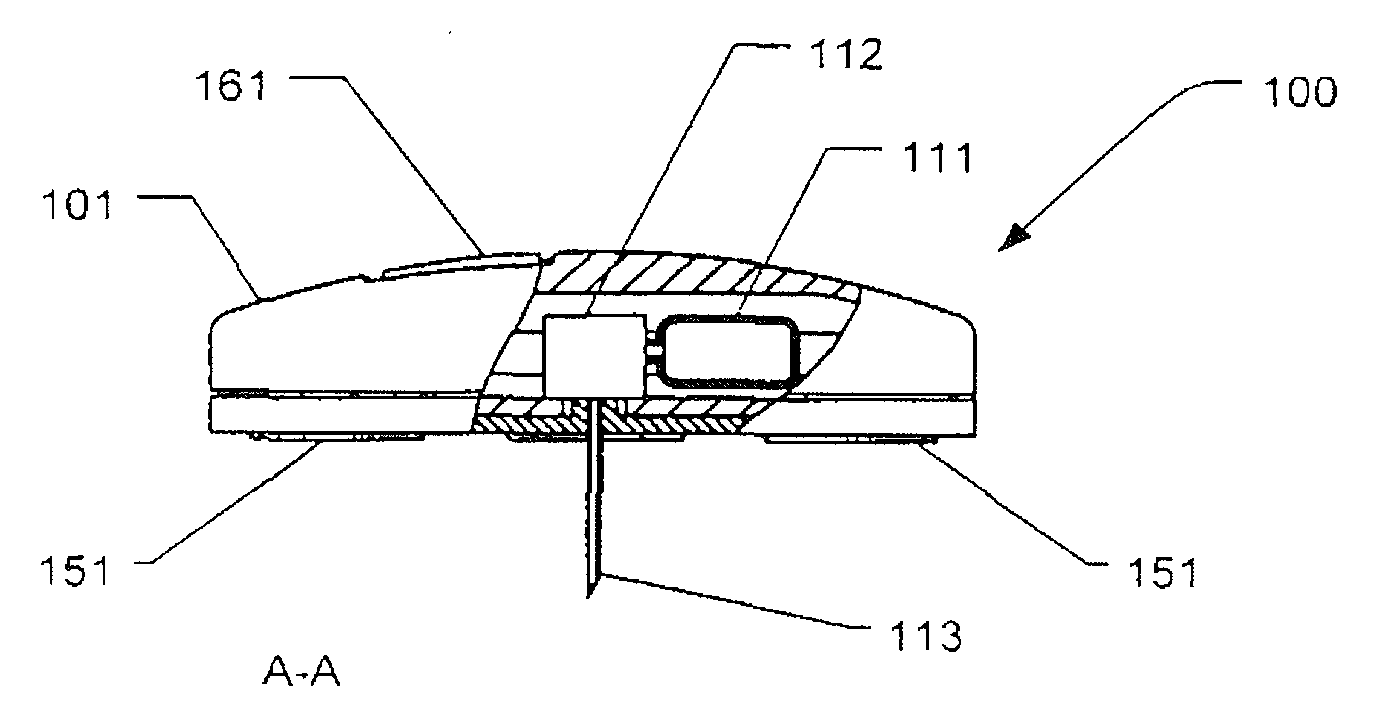Fluid Delivery Device With Integrated Monitoring Of Physiological Characteristics
a delivery device and physiological characteristic technology, applied in the field of fluid delivery devices with integrated monitoring of physiological characteristics, can solve the problems of pain in frequent blood glucose measurement on the basis of blood samples, unsuitable continuous monitoring, and inability to meet the needs of continuous monitoring, etc., to achieve the effect of effective and reliable monitoring
- Summary
- Abstract
- Description
- Claims
- Application Information
AI Technical Summary
Benefits of technology
Problems solved by technology
Method used
Image
Examples
second embodiment
[0084]drug delivery device 100 illustrated in FIGS. 2a-2d includes a housing 101 of disc or cylindrical configuration having a flat skin mounting surface 104 coated with a pressure-sensitive adhesive (not shown) for adhering the housing 101 to the skin of the subject to receive the drug. A hollow needle 113 extends through housing 101 through the skin mounting surface 104. The inner end of needle 113 communicates with a pump actuator 112 which expels metered amounts of a drug contained in reservoir 111. The outer end of needle 113 projects outwardly of the skin mounting surface 104 of the housing a short distance so as to penetrate the epidermis of the subject's skin when the housing 101 is applied adhered thereto. The rate and time of delivery of the drug is controlled by internal electrical circuitry (not shown). Housing 101 further comprises a user interface comprising push-buttons 162 and a display 161.
[0085]The lower part of housing 101 further comprises two or more first senso...
fifth embodiment
[0095]FIG. 5 illustrates the invention, wherein the skin mounting surface 104, like the embodiment shown in FIG. 4a, is provided with eight individual skin contact electrodes 151. Furthermore, the skin mounting surface 104 is provided with secondary sensor elements 152. In an exemplary embodiment, a non-invasive measurement of a substance in body fluid, such as the glucose level in blood or tissue, is performed by using radio wave impedance spectroscopy by the technique described in WO Patent application No. 02 / 069791, which is incorporated herein in its entirety. In the illustrated embodiment, the secondary sensor elements 152 comprise a ring electrode 152a and a string electrode 152b. The ring electrode 152a is arranged in electrically conductive contact with the skin of the user while string electrode 152b is electrically insulated from the skin of the user.
sixth embodiment
[0096]FIG. 6 illustrates the invention, wherein secondary sensor elements 152 are adapted for measuring skin impedance of the subject user. In this configuration a circular electrode 152c is arranged on the skin mounting surface 104 encircling a hollow needle 113 of the drug delivery device 101. Preferably, a layer of an electrically insulating material is provided along the outer surface of the hollow needle 113 at the end of the needle facing the skin mounting surface 104, while leaving the tip point of the needle exposed to electric interactions. When the drug delivery device is affixed to the user, the tip end of the hollow needle will be in electrical contact with the subdermal tissue and the circular electrode 152c is in electrically conductive contact with the skin of the user. Associated circuitry (not shown) provides the necessary means of recording skin impedance (e.g. DC conductivity, frequency response) and hence provides supplementary physiological parameters for suppor...
PUM
 Login to View More
Login to View More Abstract
Description
Claims
Application Information
 Login to View More
Login to View More - R&D
- Intellectual Property
- Life Sciences
- Materials
- Tech Scout
- Unparalleled Data Quality
- Higher Quality Content
- 60% Fewer Hallucinations
Browse by: Latest US Patents, China's latest patents, Technical Efficacy Thesaurus, Application Domain, Technology Topic, Popular Technical Reports.
© 2025 PatSnap. All rights reserved.Legal|Privacy policy|Modern Slavery Act Transparency Statement|Sitemap|About US| Contact US: help@patsnap.com



